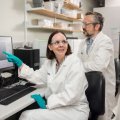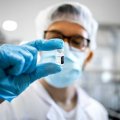The University of Queensland is the nation’s second largest recipient of Australian Research Council (ARC) Linkage – Infrastructure Equipment and Facilities (LIEF) 2003 funding in grants announced yesterday by Federal Education, Science and Training Minister Dr Brendan Nelson.
UQ was awarded seven LIEF grants that attracted $2.265 million in ARC funds, to which institutional and industry partners will add approximately $2 million.
This was second only to the University of Sydney, which was awarded nine ARC LIEF grants. The Australian National University and University of Adelaide were each awarded four grants. Within Queensland, James Cook University was awarded two LIEF grants and Queensland University of Technology one grant.
The University was also a partner institution in a further four projects headed by universities in New South Wales and South Australia and a participant in the Ocean Drilling consortium project.
The highest funding allocation to a UQ-led project was $500,000 for a Cell Sorter Facility for Neuroscience and Related Biotechnology. The aim of the project is to establish the world’s first cell-sorting facility dedicated to the production of nerve cells suitable for molecular characterisation and screening, providing the basis for identifying key molecules regulating brain function, ageing and repair.
Other UQ grants were:
* $400,000 for a high-performance computing and web facility for genome bioinformatics to provide a common software development environment for molecular biosciences, systems biology and complex systems modeling;
* $390,000 for the study of metal-centered molecules of biological interest through the construction of advanced spectrometers to probe the structure of enzymes and proteins;
* $320,000 for a high throughput structural biology screening facility to allow Queensland researchers to keep pace with the enormous acceleration in the rate of protein structure determination;
* $312,000 for an Australian Creative Resources Archive to digitise previously wasted cultural materials and create a resource to stimulate broadband content development;
* $193,000 for the development of cutting-edge technology to characterise metals and metalloids in toxicological studies; and
* $150,000 for upgrading the Gatton-based research wind tunnel for simulating particle drift in agricultural pesticide spraying.
Professor David Siddle, Deputy Vice-Chancellor (Research), said that he was delighted with the results. “These results mean that UQ and its partners will be able to put in place significant infrastructure that will enable further first class research.”
“The researchers concerned deserve high praise for their wonderful efforts,” said Professor Siddle.
Media: For further information, contact Professor Siddle (telephone 07 3365 9044), Nicole Thompson (telephone 07 3365 4445) or Brad Turner at UQ Communications (telephone 07 3365 2659 or email: communications@uq.edu.au).
.jpg)



